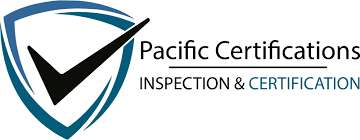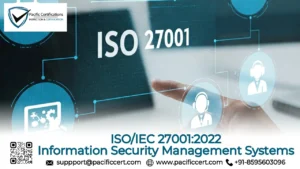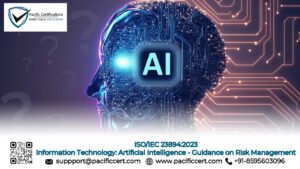What is ISO 18587?
ISO 18587:2017 defines the requirements for full, human post-editing of machine translation (MT) output within professional translation services. This international standard ensures that machine-generated translations are reviewed and refined by trained linguists to produce output that is comparable to human translation quality.

As machine translation technologies like neural machine translation (NMT) and statistical machine translation (SMT) become widely adopted, ISO 18587:2017 establishes clear guidelines to ensure that quality, accuracy and appropriateness are not compromised. It is applicable to translation service providers (TSPs), enterprises, language technology developers, and clients who utilize post-edited MT as part of their localization workflows.
Need support with ISO 18587? Contact us at support@pacificcert.com!
Scope and Applicability
ISO 18587:2017 provides requirements for the process of full post-editing of machine translation output, ensuring the final product meets the same linguistic and quality standards as a fully human-translated text. The standard applies to:
- Translation service providers (TSPs) who incorporate machine translation into their workflows
- Enterprises managing multilingual content through MT platforms
- Governmental and international organizations that rely on translated documents for legal, public, or administrative purposes
- Freelance linguists and post-editors working under ISO-aligned translation frameworks
It applies only to full post-editing, not light post-editing or raw MT output use. The standard is relevant across industries from legal to e-commerce translation workflows, where quality and consistency are critical.
Need clarification on ISO 18587 applicability to your translation projects? Email support@pacificcert.com.
Key Definitions in ISO 18587
- Machine Translation (MT): Automated translation of text using algorithms without human involvement
- Post-Editing: Human revision and correction of MT output to ensure linguistic and contextual quality
- Full Post-Editing: Editing MT output so that it is indistinguishable from a human translation in terms of fluency and accuracy
- Translation Service Provider (TSP): An organization or individual delivering translation and localization services
- Client Brief: Information provided by the client that defines expectations, terminology preferences, and usage context
Core Requirements of ISO 18587
Section | Key Requirements |
General Principles | Post-editing must achieve the same quality level as human translation |
Human Resources and Competence | Post-editors must be trained linguists with MT post-editing experience |
Pre-Production | Clear client brief, project scope, MT engine description, and expected outcomes |
Post-Editing Process | Full correction of grammar, semantics, style, terminology, formatting, and tone |
Quality Assurance | Review and validation of post-edited content to meet client-specific criteria |
Confidentiality and Security | Protection of sensitive content during post-editing and file handling |
Feedback and Continuous Improvement | Collection of quality data to enhance MT systems and workflows |
These requirements aim to standardize output quality and support consistent delivery across TSPs and clients.
How to implement ISO 18587?
- Develop workflow procedures that define stages of MT post-editing, QA, and delivery
- Use trained post-editors who meet linguistic, technical, and subject matter criteria
- Maintain MT engine documentation, describing its type, domain, and performance expectations
- Provide clear client briefs specifying language pairs, tone, terminology, and formatting
- Monitor and control the full post-editing process to ensure naturalness, meaning accuracy, and terminology consistency
- Integrate quality assurance checks for grammar, syntax, coherence, and contextual accuracy
- Secure content by adhering to data protection protocols and NDAs
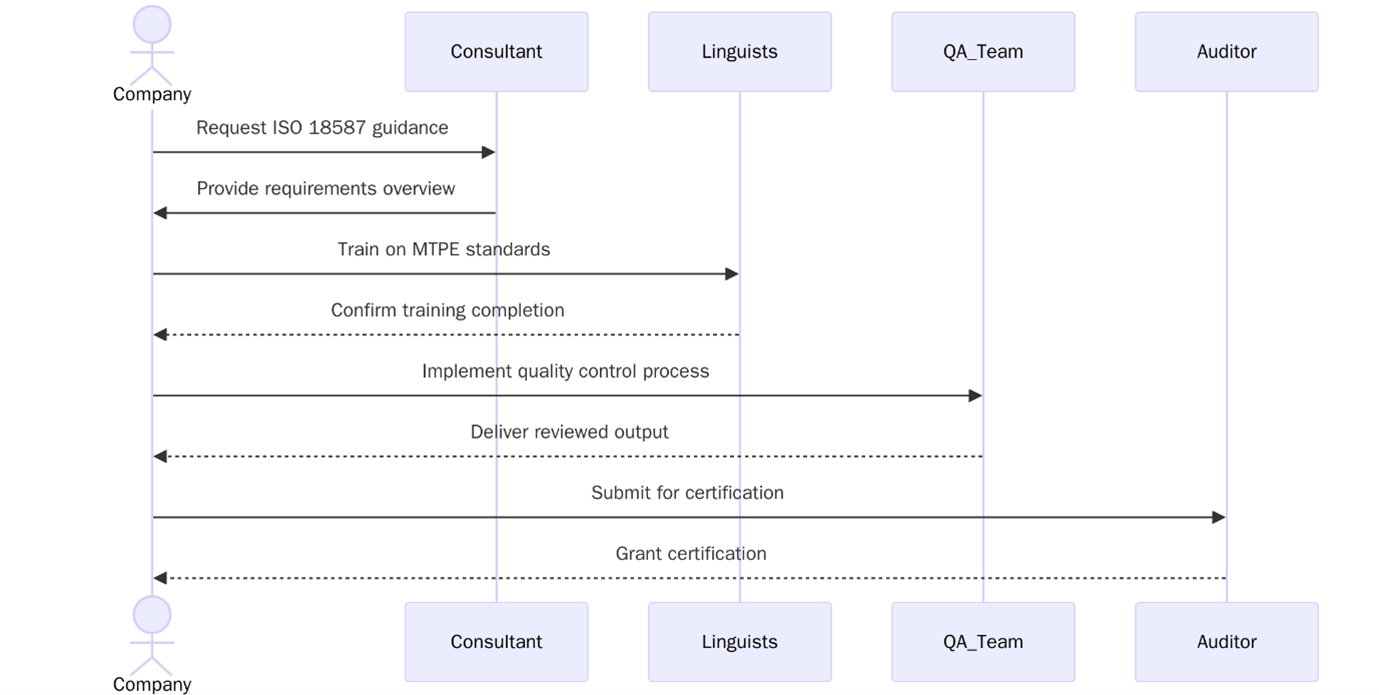
Documentation Required
To demonstrate alignment with ISO 18587, maintain the following documentation:
- Post-editing procedures and workflow charts
- Post-editor qualification and training records
- MT engine description and application reports
- Client briefs, project scopes, and output specifications
- Quality review templates and error classification logs
- Feedback forms and revision history
- Data privacy policies and access controls
- Continuous improvement logs (for engine or process updates)
What are the benefits of ISO 18587?
IN this era, machine translation is an integral part of global content strategies. With AI advancements in neural translation models and the increasing demand for real-time localization, organizations are balancing speed and cost with linguistic quality and accountability. ISO 18587 offers these benefits:
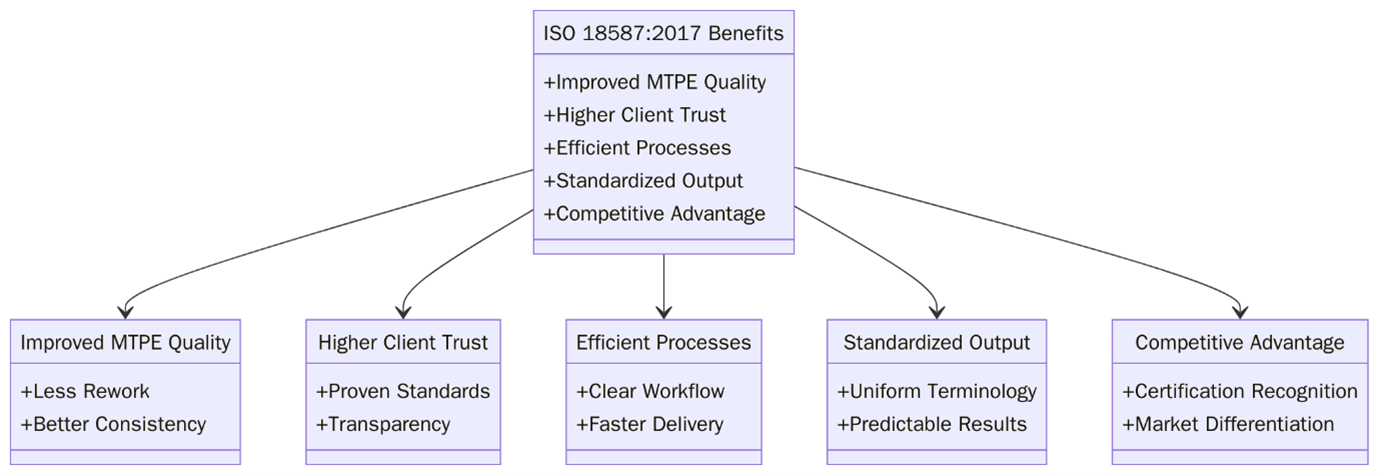
- Ensures high-quality, human-standard translation from machine output through defined editorial practices
- Enables cost-effective localization by combining automation with human refinement
- Enhances consistency and reliability in multilingual projects and content pipelines
- Facilitates faster turnaround times with minimal quality compromises
- Builds client confidence by adhering to internationally accepted post-editing standards
- Supports scalable, repeatable translation workflows for large-volume content
- Promotes accountability and traceability in translation projects involving machine output
- Aligns with ISO 17100 (Translation Services Requirements) for broader translation quality compliance
- Allows integration into ISO 9001-certified quality systems for language service providers
- Helps organizations meet procurement requirements for certified translation services in regulated sectors
ISO 18587 is now widely referenced in public tenders, vendor contracts, and global content management systems, especially in sectors like legal and e-commerce. Major buyers require assurance that MT output undergoes professional human post-editing, particularly for high-stakes or brand-critical content.
Additionally, with increasing scrutiny on data protection and AI transparency, ISO 18587 provides a neutral, audit-friendly framework for documented language quality, ethical AI integration, and operational reliability in translation.
Want to align your translation workflows with global standards for MT quality? Contact support@pacificcert.com.
How Pacific Certifications Can Help?
As a recognized certification body, Pacific Certifications offers audit and certification services for ISO standards relevant to language service providers, localization teams, and AI-integrated translation environments, including:
- ISO 17100 – Translation Services
- ISO 9001 – Quality Management Systems
- ISO/IEC 27001 – Information Security for data protection in translation
- ISO 18587 – Referenced for assessment as part of ISO 17100 audits
We also offer:
- Assessment of post-editing workflows for quality assurance
- Review of post-editor qualifications, training, and client briefs
- Audit of MT tool usage, output control, and revision protocols
- Integration of ISO 18587 into ISO-certified management systems
- Certificate of compliance for ISO 18587
To begin your audit or certification aligned with ISO 18587 standards, contact support@pacificcert.com.
FAQs
Is ISO 18587 certifiable?
It is a guidance standard, it is commonly assessed as part of ISO 17100 or ISO 9001 translation audits.
Who should use ISO 18587?
Language service providers, freelance post-editors, corporate localization teams, and AI developers integrating MT into their workflows.
What is the difference between full and light post-editing?
Full post-editing results in output indistinguishable from human translation. Light post-editing only corrects major errors, leaving some MT characteristics intact.
Can ISO 18587 be used with neural machine translation (NMT)?
Yes. The standard is technology-agnostic and applies to all MT types, including NMT, SMT, or rule-based systems.
Can Pacific Certifications audit ISO 18587 implementation?
We audit how ISO 18587 is applied within ISO 17100 or ISO 9001 systems, especially for translation quality and process control.
Ready to get 18587 certified?
Contact Pacific Certifications to begin your certification journey today!
Suggested Certifications –
Read more: Pacific Blogs
